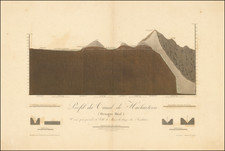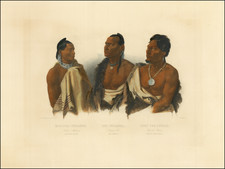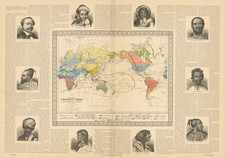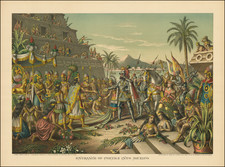An original watercolor by Captain William H. Shippard, after a page from the Codex Bodley.
Shippard's caption title on the present watercolor cites Agostino Aglio, suggesting that he made this copy from Lord Kingsborough's Mexican Antiquities.
Mss 2858 Bodley Col. page 19 Aglio Vol. 1st.
The Codex Bodley
The Codex Bodley is a vital artifact for understanding the Mixtec culture, particularly in regard to the intricate family relationships and dynastic histories of the Mixteca Alta region. Its creation date is uncertain but believed to be prior to the Spanish conquest of Mexico in 1521. The manuscript's journey to the Bodleian Library at Oxford, where it joined the collection in the early 17th century, is shrouded in mystery, with suggestions that it may have once belonged to Bishop Heronymous Osorius of Faro, Portugal, and possibly came into the possession of the library through looting by Robert Devereux, 2nd Earl of Essex, subsequently gifted to Thomas Bodley.
Crafted from deerskin and extending to 6.7 meters (22 feet) when unfolded, the Codex Bodley is an accordion-folded document, its pages coated with white paint and divided by red bands into sections for the inscription of its narratives. Over time, the codex's condition has deteriorated, with parts of its pictography fading or missing. Despite this, it remains an indispensable resource for studying the social structures, alliances, and interactions within and between the Mixtec communities, particularly those centered around the dynasties of Tilantongo and Tiaxiaco in what is now Oaxaca, Mexico.
The Codex Bodley's narratives focus on these dynasties, detailing their genealogies and significant events such as the War of Heaven and the stories related to Eight Deer, a pivotal figure linking the Tilantongo dynasty to other high-ranking Mixtec lineages. The document contrasts the origins and destinies of competing families, offering unique insights into the cultural and political landscapes of pre-conquest Mesoamerica. Its historical and academic significance is further highlighted by archaeological interpretations, such as those by Alfonso Caso, who elucidated the lineage of Tilantongo's royal family and its implications for understanding regional power dynamics.
William Henry Shippard's Mexican Paintings
William H. Shippard (1803-1865) was a pioneering 19th-century British museologist - an unsung progenitor of modern-day museum anthropology. While he is chiefly remembered as a friend of George Catlin, Shippard's profound interest in the ancient civilizations of Mexico connects him with a cohort of British contemporaries that include Lord Kingsborough and the showman William Bullock. Shippard's fascination with Mesoamerica propelled him to amass a significant collection of visual material derived from Aztec codices which he copied himself. A figure of some intrigue and scholarly ambition, Shippard endeavored to establish the Museum of Mankind in London, which seems to have evolved from his deep interest in early Mexican cultures. Although the museum did not come to fruition, Shippard's original artwork, mainly pen and ink drawings enriched with vibrant hand coloring, based on Mexican codices held in European libraries and collections, remains a valuable historical source, particularly for understanding the allure of Mexican antiquity within early 19th-century British collecting circles.
Capt. William H. Shippard, a friend of George Catlin and an avid watercolorist and museologist, was also a pioneering British Mesoamericanist. Shippard appears in British newspaper notices from the 1840s as a London-based lecturer who spoke about Native Americans and Mexican antiquities. We know he was a friend of George Catlin, and that he was involved in attempts to organize early London museum exhibitions of Mexican antiquities. In the latter efforts Shippard would seem to coincide with a group of like minded prominent English collectors interested in Mexican topics active during the 1820s and 1830s, including Lord Kingsborough and the bibliomaniac Sir Thomas Phillipps, among others. He seems to have been an armchair anthropologist and would-be museum founder, whose ambitious ideas for a London-based museum never got off the ground - at least not beyond the prospectus-printing stage. Certain aspects of Shippard's career are akin to William Bullock, the showman and connoisseur of Mexican antiquities who actually did travel to Mexico. Bullock published a notable book about his Mexican travels, and achieved a level of recognition in his day as the empresario of London's Egyptian Hall, wherein he thrilled large London audiences with his elaborate exhibitions of exotica, including Mexican items.










![(Texas Mexico Borderlands) [Map of the Rio Grande, Texas - Mexico border, from the Big Bend to the town of Mier] Copiado del Mapa de S. Mc. L. Staples, 1828... Dibujado y extractado de los documentos y datos dichos, por F. L. Mier - Monterey, Diciembre de 1873.](https://storage.googleapis.com/raremaps/img/small/91667.jpg)



